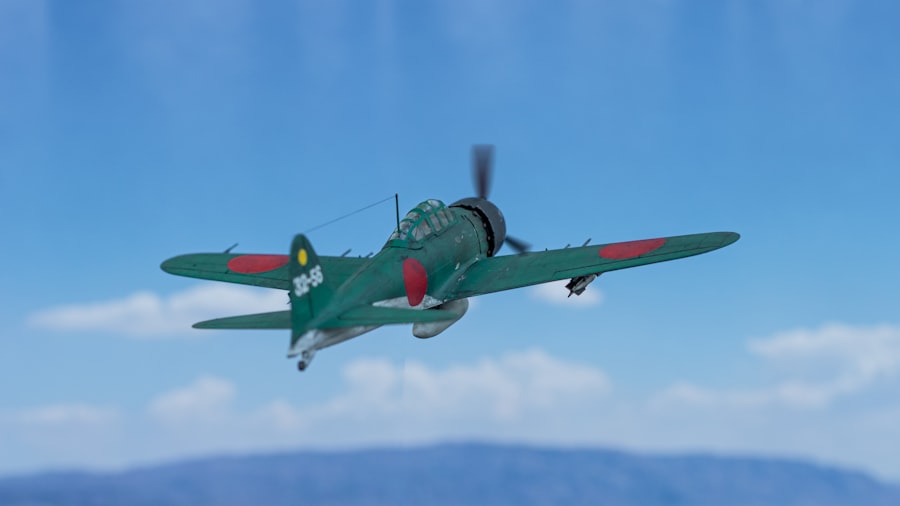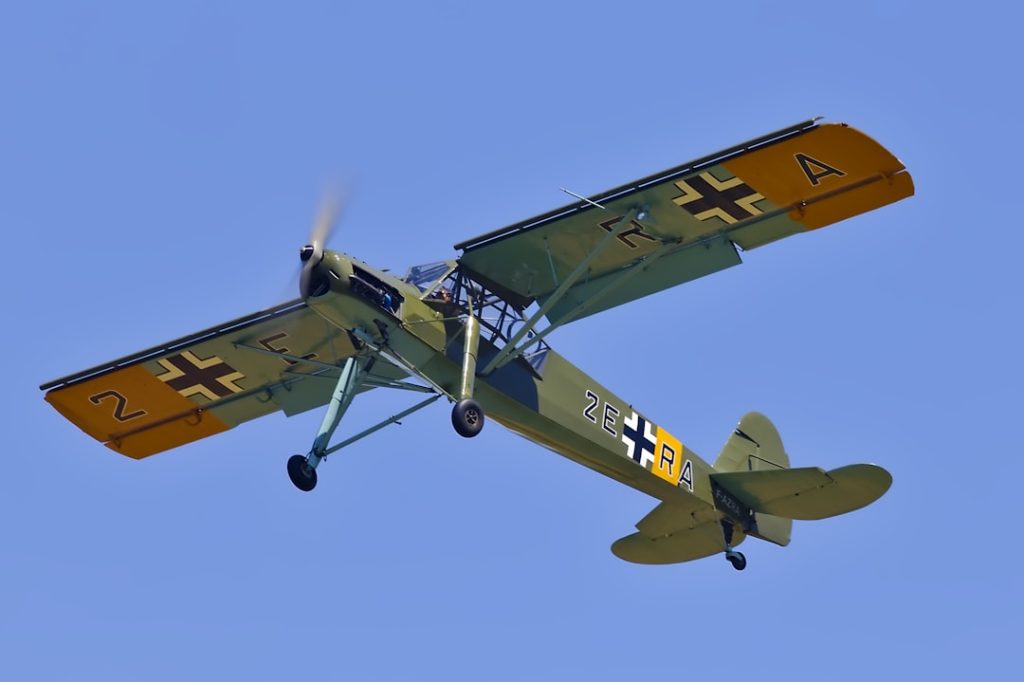The Messerschmitt Bf 109, one of the most iconic fighter aircraft of World War II, was born out of a need for a modern, high-performance fighter to meet the challenges of aerial combat in the late 1930s. The design process began in 1933 when the German government sought to re-establish its air force, which had been restricted by the Treaty of Versailles. The Luftwaffe, Germany’s air force, required a versatile aircraft that could serve multiple roles, including air superiority, ground attack, and reconnaissance.
The initial concept was to create a lightweight, agile fighter that could outperform its contemporaries. This vision was realized through the innovative engineering of Willy Messerschmitt and his team at Messerschmitt AG. The Bf 109’s design featured a low-wing monoplane configuration, which was relatively advanced for its time.
It incorporated a retractable landing gear and an enclosed cockpit, enhancing its aerodynamic efficiency and pilot protection. The aircraft was powered by the Daimler-Benz DB 601 engine, which provided exceptional speed and climb rates. The first prototype, the Bf 109 V1, took to the skies in 1935, showcasing impressive performance that would set the stage for its future success.
As testing progressed, the aircraft underwent several modifications to improve its capabilities, leading to the introduction of the Bf 109 E variant in 1937, which would become a cornerstone of Luftwaffe operations during the early years of World War
Key Takeaways
- The BF109 was developed from concept to reality as a response to a German Air Ministry requirement for a new fighter aircraft in the 1930s.
- The BF109 played a crucial role in World War II, serving as the backbone of the Luftwaffe and achieving significant success in various theaters of operation.
- The BF109 underwent numerous variants and upgrades throughout its service, adapting to changing combat requirements and technological advancements.
- Many famous pilots and aces, including Erich Hartmann and Adolf Galland, achieved remarkable success while flying the BF109 during World War II.
- The BF109 had a significant impact on aviation technology, influencing future aircraft design and engineering principles.
The BF109 in Action: Its Role in World War II

The Bf 109 quickly established itself as a formidable presence in the skies over Europe during World War
Its first major engagement came during the Spanish Civil War, where it was used by the Luftwaffe’s Condor Legion. The aircraft’s performance and firepower were instrumental in achieving air superiority for Franco’s Nationalist forces. However, it was during the Battle of Britain that the Bf 109 truly demonstrated its capabilities against a determined adversary.
The aircraft’s speed and agility allowed it to engage British fighters effectively, although it faced challenges due to limited range and fuel capacity.
| Engagement | Significance |
|---|---|
| Spanish Civil War | Instrumental in achieving air superiority for Franco’s Nationalist forces |
| Battle of Britain | Demonstrated its capabilities against a determined adversary, faced challenges due to limited range and fuel capacity |
As the war progressed, the Bf 109 became synonymous with the Luftwaffe’s air operations across various theaters. It played a crucial role in the Blitzkrieg tactics employed during the invasion of Poland and France, providing close air support to ground forces while also engaging enemy aircraft. The Bf 109’s versatility allowed it to adapt to different combat scenarios, from intercepting bombers to dogfighting with Allied fighters.
Its reputation as a deadly adversary was solidified by numerous aerial victories claimed by its pilots, making it one of the most successful fighter aircraft in history.
The Evolution of the BF109: Variants and Upgrades
The Bf 109 underwent continuous development throughout its operational life, resulting in numerous variants that catered to evolving combat requirements. The initial E series was followed by several upgrades, including the F series, which introduced improved aerodynamics and enhanced armament options. The F-4 variant featured increased firepower with additional machine guns and a more powerful engine, allowing it to compete effectively against newer Allied fighters like the Supermarine Spitfire.
As the war progressed into its later stages, the Bf 109 saw further enhancements with the G series, which became one of the most produced variants. This iteration included modifications such as a pressurized cockpit for high-altitude operations and improved armament configurations that could include cannon and rockets for ground attack missions. The final major variant, the K series, represented the pinnacle of Bf 109 development, boasting advanced features like a more powerful engine and improved visibility for pilots.
Despite these advancements, by this time, Allied aircraft had also evolved significantly, leading to increasingly challenging combat scenarios for Bf 109 pilots.
Famous Pilots and Aces who Flew the BF109

The Bf 109 was flown by many of history’s most renowned fighter pilots, contributing to its legendary status in aviation lore. Among these aces was Erich Hartmann, who holds the record for the highest number of aerial victories in history with 352 confirmed kills. Hartmann’s exceptional skill and tactical acumen allowed him to dominate the skies over Eastern Europe while flying various Bf 109 variants.
His success was attributed not only to his flying prowess but also to his ability to exploit the strengths of the Bf 109 in combat situations. Another notable pilot was Adolf Galland, who became one of Germany’s leading aces and later served as a general in charge of fighter forces. Galland’s experience with the Bf 109 allowed him to advocate for improvements in tactics and aircraft design based on his frontline experiences.
His leadership and insights were instrumental in shaping Luftwaffe strategies throughout the war. These pilots exemplified the capabilities of the Bf 109 and contributed to its legacy as one of the most effective fighters of its time.
The BF109’s Impact on Aviation Technology
The Bf 109 significantly influenced aviation technology during its era and beyond. Its design principles set new standards for fighter aircraft development, particularly in terms of aerodynamics and performance optimization. The use of a low-wing monoplane configuration became a template for future fighter designs worldwide.
Additionally, innovations such as retractable landing gear and enclosed cockpits became standard features in subsequent aircraft designs. Moreover, the Bf 109’s engine technology paved the way for advancements in powerplant design. The Daimler-Benz DB 601 engine demonstrated how liquid-cooled engines could provide superior performance compared to traditional air-cooled designs.
This shift influenced post-war aircraft development as engineers sought to harness similar technologies for improved speed and efficiency. The lessons learned from the Bf 109’s operational history also informed military aviation strategies in subsequent conflicts, highlighting the importance of adaptability and technological advancement in aerial warfare.
The Legacy of the BF109: Influence on Future Aircraft
The legacy of the Bf 109 extends far beyond its operational lifespan during World War II; it has left an indelible mark on future generations of fighter aircraft. Its design philosophy influenced numerous post-war fighters, including those developed by both Western and Eastern bloc nations. For instance, aircraft like the North American F-86 Sabre and the Soviet MiG-15 incorporated elements inspired by the aerodynamic efficiency and performance characteristics established by the Bf 109.
Furthermore, many modern fighter jets continue to reflect principles derived from the Bf 109’s design. The emphasis on speed, agility, and firepower remains central to contemporary military aviation strategies. The aircraft’s ability to adapt to various roles has also been mirrored in modern multirole fighters that can perform air-to-air combat as well as ground attack missions.
As such, the Bf 109 serves as a historical benchmark against which future designs are measured.
Restoring and Preserving the BF109: The Efforts of Aviation Enthusiasts
In recent years, there has been a concerted effort among aviation enthusiasts and historians to restore and preserve surviving examples of the Bf 109. These restoration projects are often labor-intensive endeavors that require meticulous attention to detail and a deep understanding of historical accuracy. Organizations dedicated to preserving aviation history have taken on these challenges, ensuring that this iconic aircraft remains part of our collective memory.
One notable example is the restoration of a Bf 109 G-6 by a group of passionate volunteers at an aviation museum in Germany. This project involved sourcing original parts from around the world and employing skilled craftsmen who specialize in vintage aircraft restoration techniques. Such efforts not only aim to return these aircraft to flying condition but also serve as educational tools for future generations interested in aviation history.
By showcasing restored Bf 109s at airshows and museums, enthusiasts help keep alive the stories of those who flew them during one of history’s most tumultuous periods.
The BF109 Today: Where to See and Experience this Legendary Fighter
Today, enthusiasts can experience the legacy of the Bf 109 through various avenues around the world. Several aviation museums house preserved or restored examples of this legendary fighter, allowing visitors to appreciate its design and historical significance up close. Notable institutions such as the Deutsches Museum in Munich and the Imperial War Museum Duxford in England feature impressive displays that highlight not only the Bf 109 but also its role within broader military aviation history.
Additionally, airshows often feature flying demonstrations of restored Bf 109s, providing spectators with an opportunity to witness this remarkable aircraft in action once again. Events like the Flying Legends Airshow in Duxford attract aviation enthusiasts from around the globe who gather to celebrate vintage aircraft and their storied pasts. These experiences not only honor those who flew these planes but also inspire new generations to appreciate aviation history and its impact on modern technology and warfare.
Through these efforts, the legacy of the Bf 109 continues to soar high above our collective consciousness as a symbol of innovation and resilience in aviation history.


